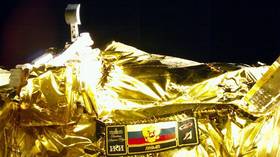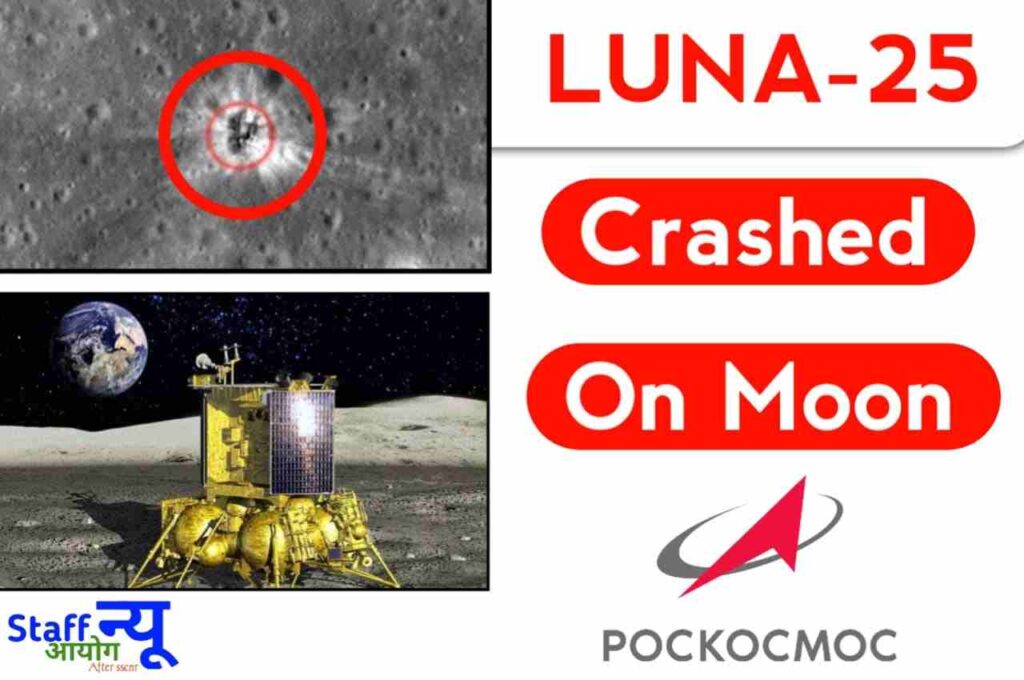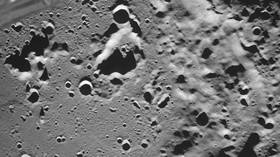Roscosmos: Russia's Space Agency

Roscosmos, also known as the Roscosmos State Corporation for Space Activities, is the coordinating hub for space activities in Russia. It performs numerous civilian activities (including Earth monitoring and the astronaut program) and coordinates with the Defense Ministry of the Russian Federation for military launches.
___________________________________________________________________________________
Russian probe crashes into Moon – Roscosmos

"Russia’s Luna-25 automatic interplanetary station has collided with the Moon, space agency Roscosmos has said.
“According to the results of a preliminary analysis… the Luna-25 spacecraft switched to a non-designated orbit and ceased to operate due to a collision with the surface of the Moon,” Roscosmos said on Sunday.
- Efforts on Saturday and Sunday to locate the craft and restore contact were unsuccessful.
- A commission involving representatives of several agencies will be assembled to establish the reasons for the loss of the probe, Roscosmos said.
The mission aimed to achieve the first ever landing near the south pole of Earth’s satellite, known for its difficult terrain.
The main goal of the mission was to examine the lunar soil for the presence of ice, with Roscosmos also saying it wanted to test soft-landing technology and conduct long-term research on the lunar exosphere and the upper layer of the south pole’s surface.
807 Comments
___________________________________________________________________________________
Russia's first moon lander in 47 years has crashed into the lunar surface, the country's space agency reported on Sunday (Aug. 20).
The Luna-25 lander, which Russia had hoped would land at the south pole of the moon as early as Monday (Aug. 21), crashed into the moon after an orbital maneuver went wrong yesterday (Aug. 19), officials with Russia's Roscosmos space agency said.
"At about 14:57 Moscow time [on Aug. 19], communication with the Luna-25 spacecraft was interrupted," Roscosmos wrote in an update on Telegram today (in Russian; translation by Google). "The measures taken on August 19 and 20 to search for the device and get into contact with it did not produce any results."
Related: Russia launches Luna-25 moon lander, its 1st lunar probe in 47 years
A preliminary analysis suggests that the wayward orbital maneuver sent Luna-25 into an unexpected trajectory, one in which the moon lander "ceased to exist as a result of a collision with the lunar surface," Roscosmos wrote.
Aside from hunting water ice, Luna 25's main science goals included examining the regolith and rocks around it, looking at the wispy lunar atmosphere and testing out technology for future landings on the moon.
Russian aerospace company NPO Lavochkin designed and built the lander, which had two major parts: a landing platform with a propulsion system; and landing gear, including a velocity and range meter for use during landing. Also on the lander was a non-pressurized instrument container for items such as solar panels, radiators, antennas, television cameras, a power source and scientific equipment.
The loss of Luna-25 could be a major blow to Russia's plans to fly a series of moon missions and its effort to develop a permanent crewed based on the moon with China.
Roscosmos plans to follow Luna-25 with a lunar orbiter, called Luna-26, and then two more landing missions: Luna-27, which will send a drilling rig to the lunar surface; and Luna-28, a sample-collection mission that aims to return material from the moon's polar regions to Earth.
Related: Missions to the moon: Past, present and future
Roscosmos officials said Sunday that they have already formed a team to investigate the crash of Luna-25.
"A specially formed interdepartmental commission will deal with the issues of clarifying the reasons for the loss of the moon [lander]," Roscosmos wrote in the Telegram update.
NASA plans to land the crewed Artemis 3 mission near the south pole in late 2025 or 2026, provided that Artemis 2 loops around the moon as planned with its crew in late 2024 and that the spacesuits and lander (SpaceX's new Starship vehicle) are ready. NASA also has help fund a series of commercial robotic landers, some of which may touch down on the moon as soon as this year.
Editor's note: This story was updated at 9:25 a.m. EDT to include the statement from Roscomos that Luna-25 had crashed into the moon. Space.com Editor-in-Chief Tariq Malik contributed to this report.






.jfif)
No comments:
Post a Comment